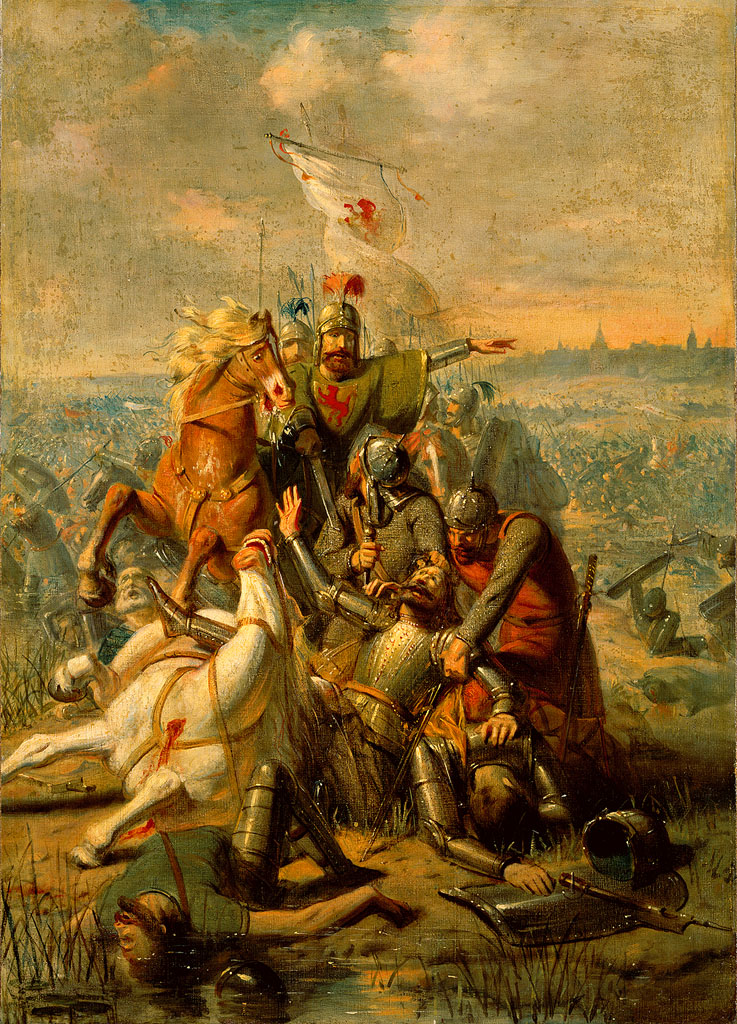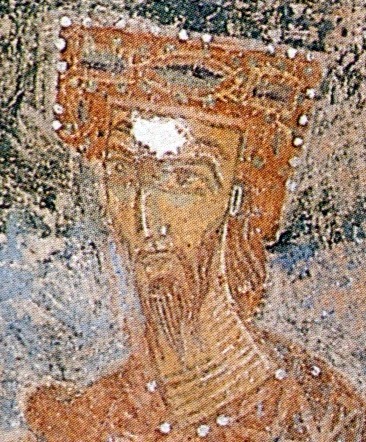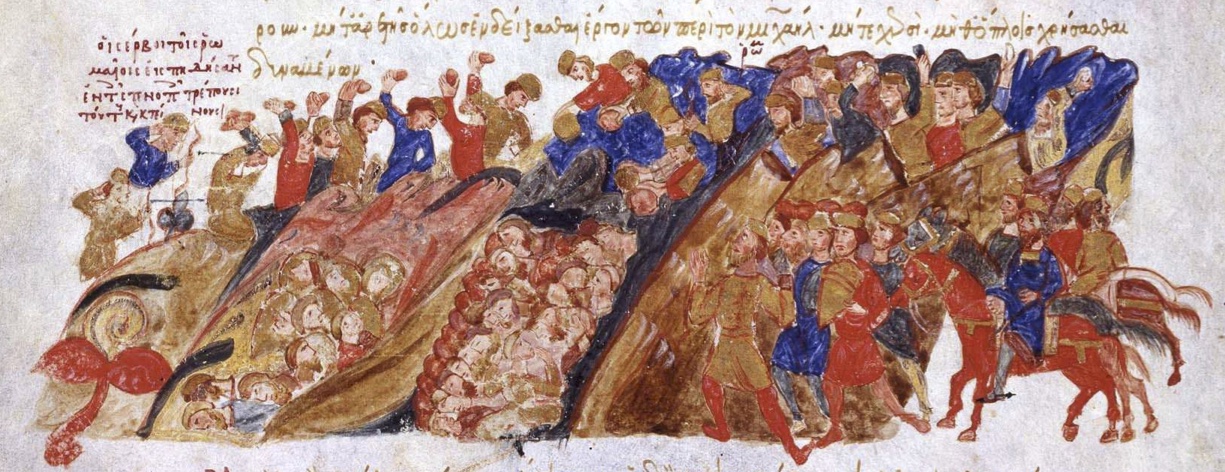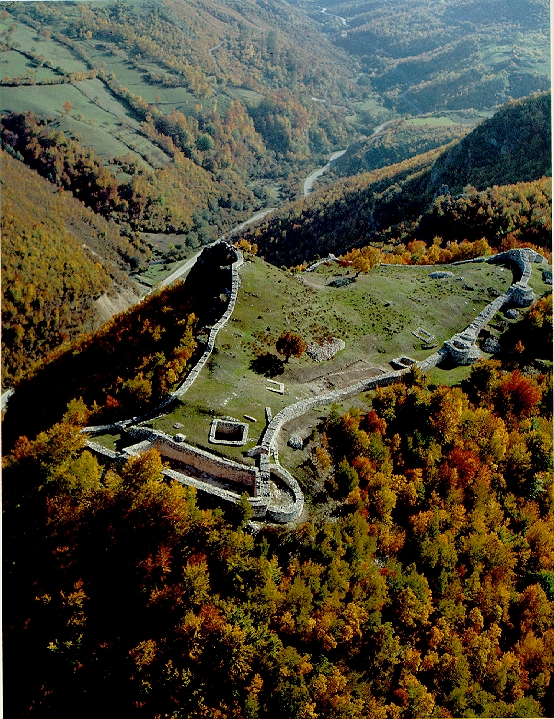|
Dragimir Hvalimirović
Dragimir (Serbian Cyrillic: Драгимир; † 1018) or Dragomir (Драгомир) was ruler of Travunia and Zachlumia, medieval Serbian principalities located in present-day regions of Herzegovina and south Dalmatia, from an unknown date before 1000 to 1018.Živković 2006, "Стефан Војислав". Biography The only preserved medieval source that mentions Dragimir is the dubious Chronicle of the Priest of Duklja, specifically its Chapters 34–37. Chapter 34 relates to "King" Hvalimir who divided his domain among his sons, giving Zenta to his first-born Petrislav, Travunia and Zachlumia to Dragimir, and Podgoria to the youngest Miroslav.Stephenson 2010,Chronicle of the Priest of Duklja, Chapters 30-35". After Miroslav died without an heir, his land was taken over by Petrislav, who thus ruled all of Duklja (Zenta and Podgoria). However this is contradictory to the earlier and more trusted De Administrando Imperio which states that Hvalimir's son was Čučimir, lea ... [...More Info...] [...Related Items...] OR: [Wikipedia] [Google] [Baidu] |
Vojislav Of Duklja
Stefan Vojislav ( sr-Cyrl, Стефан Војислав, ; 1034–d. 1043) was the Prince of Duklja from 1018 to 1043. Beginning in the year 1018, he served as a Byzantine governor, until 1034 when he led an unsuccessful revolt that landed him in a prison at Constantinople. He managed to escape and returned home, this time successfully gaining the independence of his statelet and expanding his rule over southern Dalmatia and its hinterland. He is the eponymous founder of the Vojislavljević dynasty. Origin and early life The contemporary Byzantine writers call him either a Serb or a Dukljan (''Βοϊσθλάβος ὁ Διοκλητιανός)'', but do not mention his genealogy, while the ''Chronicle of the Priest of Duklja'', a posterior, more dubious source, calls him a cousin to previous ruler Jovan Vladimir (r. 990–1016).Živković 2006, "Стефан Војислав". Having reached its pinnacle during the long reign of emperor Basil II, the Byzantine Empire entered a ... [...More Info...] [...Related Items...] OR: [Wikipedia] [Google] [Baidu] |
First Bulgarian Empire
The First Bulgarian Empire (; was a medieval state that existed in Southeastern Europe between the 7th and 11th centuries AD. It was founded in 680–681 after part of the Bulgars, led by Asparuh of Bulgaria, Asparuh, moved south to the northeastern Balkans. There they secured Byzantine Empire, Byzantine recognition of their right to settle south of the Danube by Battle of Ongal, defeatingpossibly with the help of Seven Slavic tribes, local South Slavic tribesthe Byzantine army led by Constantine IV. During the 9th and 10th century, Bulgaria at the height of its power spread from the Danube Bend to the Black Sea and from the Dnieper River to the Adriatic Sea and became an important power in the region competing with the Byzantine Empire. As the state solidified its position in the Balkans, it entered into a centuries-long interaction, sometimes friendly and sometimes hostile, with the Byzantine Empire. Bulgaria emerged as Byzantium's chief antagonist to its north, resulting in ... [...More Info...] [...Related Items...] OR: [Wikipedia] [Google] [Baidu] |
1018 Deaths
Year 1018 ( MXVIII) was a common year starting on Wednesday of the Julian calendar. Events By place Europe * January 30 – The Peace of Bautzen: Emperor Henry II signs a peace treaty with Bolesław I the Brave, Duke of Poland, ending the German–Polish War. Poland keeps Lusatia – the Holy Roman Empire keeps Bohemia. With this peace agreement, Bolesław redirects his forces on an offensive against the Kievan Rus'. * July 22– 23 – Battle of the River Bug: Polish forces under Bolesław I defeat Yaroslav the Wise near the River Bug. Yaroslav retreats to Novgorod, abandoning Kiev. * July 29 – Battle of Vlaardingen: Henry II sends an army towards Holland to subdue the rebellious Count Dirk III. The Imperial forces are defeated near Vlaardingen. * August – Ivats, Bulgarian nobleman and rebel leader, is blinded and captured by ''strategos'' Eustathios Daphnomeles, confirming Bulgaria's position as part of the Byzantine Empire. * August 14 &nd ... [...More Info...] [...Related Items...] OR: [Wikipedia] [Google] [Baidu] |
University Of Michigan Press
The University of Michigan Press is a university press that is a part of Michigan Publishing at the University of Michigan Library. It publishes 170 new titles each year in the humanities and social sciences. Titles from the press have earned numerous awards, including Lambda Literary Awards, the PEN/Faulkner Award, the Joe A. Callaway Award, and the Nautilus Book Award. The press has published works by authors who have been awarded the Pulitzer Prize, the National Humanities Medal and the Nobel Prize in Economics. History From 1858 to 1930, the University of Michigan had no organized entity for its scholarly publications, which were generally conference proceedings or department-specific research. The University Press was established in 1930 under the university's Graduate School, and in 1935, Frank E. Robbins, assistant to university president Alexander G. Ruthven, was appointed as the managing editor of the University Press. He would hold this position until 195 ... [...More Info...] [...Related Items...] OR: [Wikipedia] [Google] [Baidu] |
Vojislavljević Dynasty
The House of Vojislavljević ( sr-Cyrl, Војислављевић, pl. Vojislavljevići / Војислављевићи) was a Serbian medieval dynasty, named after ''archon'' Stefan Vojislav, who wrested the polities of Duklja, Travunia, Zahumlje, inner Serbia and Bosnia from the Byzantines in the mid-11th century. His successors, kings Mihailo I Vojislavljević (d. 1081) and Constantine Bodin (d. 1101) expanded and consolidated the state. During the 12th century, the main line of the Vojislavljević family was ousted by their cadet branch, the Vukanović. (which became the Nemanjić dynasty), in the late 12th century. History Background Stefan Vojislav Stefan Vojislav, the progenitor of the dynasty, was a nobleman in Byzantine service who had the titles of ''archon'', and '' toparch'' of the Dalmatian ''kastra'' of Zeta and Ston.Kekaumenos, ed Litavrin, 170-2Paul Magdalino, ''Byzantium in the year 1000''p. 124/ref> In 1034 he led an unsuccessful revolt that resul ... [...More Info...] [...Related Items...] OR: [Wikipedia] [Google] [Baidu] |
Stefan Vojislav
Stefan Vojislav ( sr-Cyrl, Стефан Војислав, ; 1034–d. 1043) was the Prince of Duklja from 1018 to 1043. Beginning in the year 1018, he served as a Byzantine governor, until 1034 when he led an unsuccessful revolt that landed him in a prison at Constantinople. He managed to escape and returned home, this time successfully gaining the independence of his statelet and expanding his rule over southern Dalmatia and its hinterland. He is the eponymous founder of the Vojislavljević dynasty. Origin and early life The contemporary Byzantine writers call him either a Serb or a Dukljan (''Βοϊσθλάβος ὁ Διοκλητιανός)'', but do not mention his genealogy, while the '' Chronicle of the Priest of Duklja'', a posterior, more dubious source, calls him a cousin to previous ruler Jovan Vladimir (r. 990–1016).Živković 2006, "Стефан Војислав". Having reached its pinnacle during the long reign of emperor Basil II, the Byzantine Empire entered ... [...More Info...] [...Related Items...] OR: [Wikipedia] [Google] [Baidu] |
Bay Of Kotor
The Bay of Kotor ( sh-Latn-Cyrl, Boka kotorska, Бока которска, separator=" / ", ), also known as the Boka ( sh-Cyrl, Бока), is a winding bay of the Adriatic Sea in southwestern Montenegro and the region of Montenegro concentrated around the bay. It is also the southernmost part of the historical region of Dalmatia. At the entrance to the Bay there is Prevlaka, a small peninsula in southern Croatia. The bay has been inhabited since antiquity. Its well-preserved medieval towns of Kotor, Risan, Tivat, Perast, Prčanj and Herceg Novi, along with their natural surroundings, are major tourist attractions. The Natural and Culturo-Historical Region of Kotor was designated a UNESCO World Heritage Site in 1979. Its numerous Eastern Orthodox, Orthodox and Catholic Church in Montenegro, Catholic churches and monasteries attract numerous religious pilgrims and other visitors. Geography The bay is about long with a shoreline extending . It is surrounded by two massifs of the ... [...More Info...] [...Related Items...] OR: [Wikipedia] [Google] [Baidu] |
Ivan Vladislav Of Bulgaria
Ivan Vladislav (; ; died February 1018) served as the emperor (tsar) of the First Bulgarian Empire from approximately August or September 1015 until February 1018. The precise year of his birth remains elusive; he was born at least ten years prior to 987, but likely not much earlier than that. Saved from death by his cousin Gavril Radomir, the Bulgarian Emperor, in 976, Ivan Vladislav murdered him in October 1015 and seized the Bulgarian throne. Due to the desperate situation of the country following the decades-long war with the Byzantine Empire, and in an attempt to consolidate his position, he tried to negotiate truce with the Byzantine emperor Basil II. After the failure of the negotiations he continued the resistance, attempting unsuccessfully to push the Byzantines back. During his period of rule, Ivan Vladislav tried to strengthen the Bulgarian army, reconstructed many Bulgarian fortresses and even carried out a counter-offensive, but he died at the Battle of Dyrrhachium ... [...More Info...] [...Related Items...] OR: [Wikipedia] [Google] [Baidu] |
Jovan Vladimir
Jovan Vladimir or John Vladimir ( sr-cyr, Јован Владимир; – 22 May 1016) was the ruler of Duklja, the most powerful Serbs, Serbian principality of the time, from around 1000 to 1016. He ruled during the protracted war between the Byzantine Empire and the First Bulgarian Empire, Bulgarian Empire. Vladimir was acknowledged as a pious, just, and peaceful ruler. He is recognized as a Christian martyrs, martyr and saint, with his feast day being celebrated on May 22 (Eastern Orthodox liturgics), 22 May. Jovan Vladimir had a close relationship with Byzantium but this did not save Duklja from the expansionist Tsar Samuel of Bulgaria, who conquered the principality around 1010 and took Vladimir prisoner. A medieval chronicle asserts that Samuel's daughter, Theodora Kosara, fell in love with Vladimir and begged her father for his hand. The tsar allowed the marriage and returned Duklja to Vladimir, who ruled as his Vassal state, vassal. Vladimir took no part in his fa ... [...More Info...] [...Related Items...] OR: [Wikipedia] [Google] [Baidu] |
Vassal State
A vassal state is any state that has a mutual obligation to a superior state or empire, in a status similar to that of a vassal in the feudal system in medieval Europe. Vassal states were common among the empires of the Near East, dating back to the era of the Egyptian, Hittite, and Mitanni conflict, as well as in ancient China. The relationships between vassal rulers and empires were dependent on the policies and agreements of each empire. While the payment of tribute and military service was common amongst vassal states, the degree of independence and benefits given to vassal states varied. Today, more common terms are puppet state, protectorate, client state, associated state, or satellite state. Historical examples Ancient Egypt The reign of Thutmose III (1479 BC – 1425 BC) laid the foundations for the systems that functioned during the Amarna period of Egypt. Vassal states in the Levant became fully integrated in Egypt's economy with the construction of harbours � ... [...More Info...] [...Related Items...] OR: [Wikipedia] [Google] [Baidu] |
Grand Principality Of Serbia
The Grand Principality of Serbia ( sr-Cyrl-Latn, Великожупанска Србија, Velikožupanska Srbija, separator=" / "), also known by the anachronistic exonym Raška (region), Rascia ( sr-Cyrl-Latn, Рашка, Raška, separator=" / ", link=no), was a medieval Serbs, Serbian state that existed from the second half of the 11th century up until 1217, when it was transformed into the Kingdom of Serbia (1217–1346), Kingdom of Serbia. After the Grand Principality of Serbia emerged, it gradually expanded during the 12th century, encompassing various neighbouring regions, including territories of Raška (region), Raška ( sr-Cyrl, Рашка; ), modern Montenegro, Herzegovina, and southern Dalmatia. It was founded by Grand Prince Vukan, Grand Prince of Serbia, Vukan, who initially served as the regional governor of the principality ( 1082), appointed by King Constantine Bodin. During the Byzantine–Serbian wars ( 1090), Vukan gained prominence and became a self-governing ... [...More Info...] [...Related Items...] OR: [Wikipedia] [Google] [Baidu] |
Bosnia (region)
Bosnia ( sh-Latn-Cyrl, separator=" / ", Bosna, Босна, ) is the northern region of Bosnia and Herzegovina, encompassing roughly 81% of the country; the other region, the southern part, is Herzegovina. The two regions have formed a geopolitical entity since medieval times, and the name "Bosnia" commonly occurs in historical and geopolitical senses as generally referring to both regions (Bosnia and Herzegovina). The official use of the combined name started only in the late period of Ottoman rule. Geography Bosnia lies mainly in the Dinaric Alps, ranging to the southern borders of the Pannonian plain, with the rivers Sava and Drina marking its northern and eastern borders. The area of Bosnia comprises approximately 39,021 km2, and makes up about 80% of the territory of the present-day state of Bosnia and Herzegovina. There are no true borders between the region of Bosnia and the region of Herzegovina. Unofficially, Herzegovina is south of the mountain Ivan planina. A ... [...More Info...] [...Related Items...] OR: [Wikipedia] [Google] [Baidu] |








